A panel of OPEC+ technical experts agreed to revise down oil-demand estimates for 2021, signaling a more negative view of the market just days before the group decides on production policy.

The OPEC+ Joint Technical Committee now estimates that global oil demand will expand by 5.6 million barrels a day this year, down from 5.9 million previously, according to delegates and documents seen by Bloomberg.
The revision, which mainly affects the next few months, follows a recommendation from OPEC Secretary-General Mohammad Barkindo earlier on Tuesday that the coalition should remain very cautious.
Weaker Outlook
At the previous meeting, that sense of caution led to a surprise decision to maintain almost all of the cartel’s output curbs, instead of boosting production in anticipation of the economic recovery from the coronavirus pandemic. The Organization of Petroleum Exporting Countries and its allies believe that decision has since been vindicated and the group is widely expected to take a similar stance this week.
The panel “noted with concern that despite the accelerated rate of vaccination roll-outs across the world, there are a rising number of confirmed Covid-19 infections globally, with lockdown measures and travel restrictions being reimposed in many regions,” according to the documents.
The reduction is most pronounced from April to June, when on average consumption is now seen 1 million barrels a day lower than prior projections.
That implies that the cartel’s primary goal for the coming months -- running down excess fuel inventories built up during the pandemic -- would only happen slowly unless its production cuts are maintained close to current levels.
Fuel demand in the U.S. has shown strong signs of a rebound, but a resurgence of the virus has undermined the recovery elsewhere. That has convinced the cartel it made the right call at its last meeting.
“Given the development of the coronavirus, particularly in Europe, the demand growth has been much slower to come back,” Torbjorn Tornqvist, chairman and chief executive officer of oil trader Gunvor Group Ltd., said in an interview. “The U.S., actually, looks pretty good, but stocks are not coming down as fast as we thought.”
In the days after the March 4 meeting, when OPEC+ shocked the market by maintaining most of its production cuts, Brent soared to $70 a barrel.
Yet the rally soon dissolved as parts of Europe reimposed lockdowns to contain a virulent strain of the coronavirus, while India and Brazil contended with worsening outbreaks. Crude purchases in Asia slowed as a lackluster tourist season failed to stimulate fuel demand. Meanwhile, oil supplies swelled as Iran ramped up exports to China in defiance of U.S. sanctions.
Within a week of hitting a one-year high, oil futures had surrendered almost $10. Brent crude, the international benchmark, traded 0.8% higher at $64.63 a barrel on at 7:50 a.m. in London.
“Oil prices are going to stay where they are, $65-ish give or take a bit,” said Tornqvist. He said he believes OPEC+ will defend this price level.